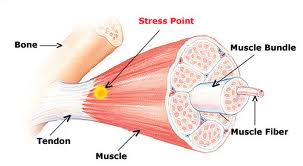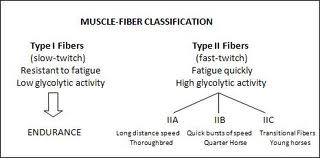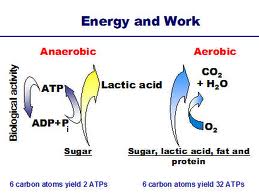Hidez Science
Muscle Structure & Function in Horses
Muscle Structure
Whether in horses or humans, each muscle consists of thousands of cells bundled together to form a functional unit. Skeletal muscles are covered with a protective sheath that eventually forms tendons and ligaments. Muscles have a plentiful blood supply to deliver oxygen and nutrients while removing toxic waste substances produced during high levels of activity.

Equine muscle fibers are classified as either slow twitch (Type I) or fast twitch (Type II) fibers:
- Type I (Slow Twitch): Highly oxidative, aerobic fibers used for endurance. Fatigue-resistant and capable of reducing lactic acid build-up.
- Type II (Fast Twitch): Subdivided into Type II A (high & low oxidative, aerobic + anaerobic, for speed & jumping) and Type II B (low oxidative, highly anaerobic, for speed). Fatigue faster than Type I fibers.
Different horse breeds have distinct ratios of Type I to Type II fibers depending on their performance type. Quarter Horses and Thoroughbreds have fewer Type I fibers compared to Arabians or Andalusians.

Muscle Energy Sources
All muscle cells rely on high-energy phosphate bonds for energy. The breakdown of these bonds releases energy, powering muscle contraction, enzymes, and cellular functions.
- Creatine Phosphate (Phosphocreatine): Provides immediate energy but lasts less than a minute.
- ATP (Adenosine Triphosphate): The primary energy currency of cells, produced from glucose (glycogen), fats, and proteins. ATP is continually used, remade, and recycled. Without ATP, muscles cannot function.
How Muscles Act
Muscles contract by using ATP to trigger interactions between muscle fibers. The process releases a phosphate ion from ATP, forming ADP. This phosphate is replenished by energy derived from sugar metabolism and stored creatine phosphate, regulated by the enzyme Creatine Kinase (CK).

Key Points:
- ADP and ATP concentrations in muscles are relatively small. CK is abundant but rapidly depleted during intense short-term exercise, while ATP remains stable.
- Anaerobic metabolism produces lactic acid rapidly, while aerobic metabolism slowly breaks down lactic acid into CO₂ for exhalation.
- Overworked or overstretched fibers leak CK into the bloodstream, making it a marker for muscle injury.
References
- Murray Stewart, Muscle Structure and Function – An Explanation, Equine Vet. Journal, 1976
- Seeherman MW, O’Callaghan SH, Schelling MR, Steckel RS, Skeletal Muscle Damage in Horses after Strenuous Exercise, Equine Vet. Journal, 1991
- MacLeay JM, Billstrom JA, Hower-Moritz MA, Mickelson JR, Skeletal Muscle Metabolic Response to Exercise in Horses with Tying-Up, Equine Vet. Journal, 1999
- Leisson K, Jaakma U, Seene T, Adaptation of Locomotor Muscle Fiber Types to Training, Journal of Equine Vet. Science, 2008
- Eessen-Gustavsson B, Valberg S, Blood and Muscle Ammonia Concentrations in Horses, Equine Exercise Physiology, 1987
- Cutmore CM, Snow DH, Newsholme EA, Effects of Training on Enzyme Activities in Thoroughbreds, Equine Vet., 1986
- Snow DH, Harris RC, Gash SP, Metabolic Response of Equine Skeletal Muscle to Intermittent Maximal Exercise, J. Appl. Physiol, 1985
- Saltin B, Gollnick PD, Skeletal Muscle Adaptability: Significance for Metabolism and Performance, Handbook of Physiology, 1983
- Brown NA, Kawcak CE, Architectural Properties of Distal Forelimb Muscles in Horses, Equus caballus, Journal of Morphology
Contact Hidez for More Information About Equine Muscle Support